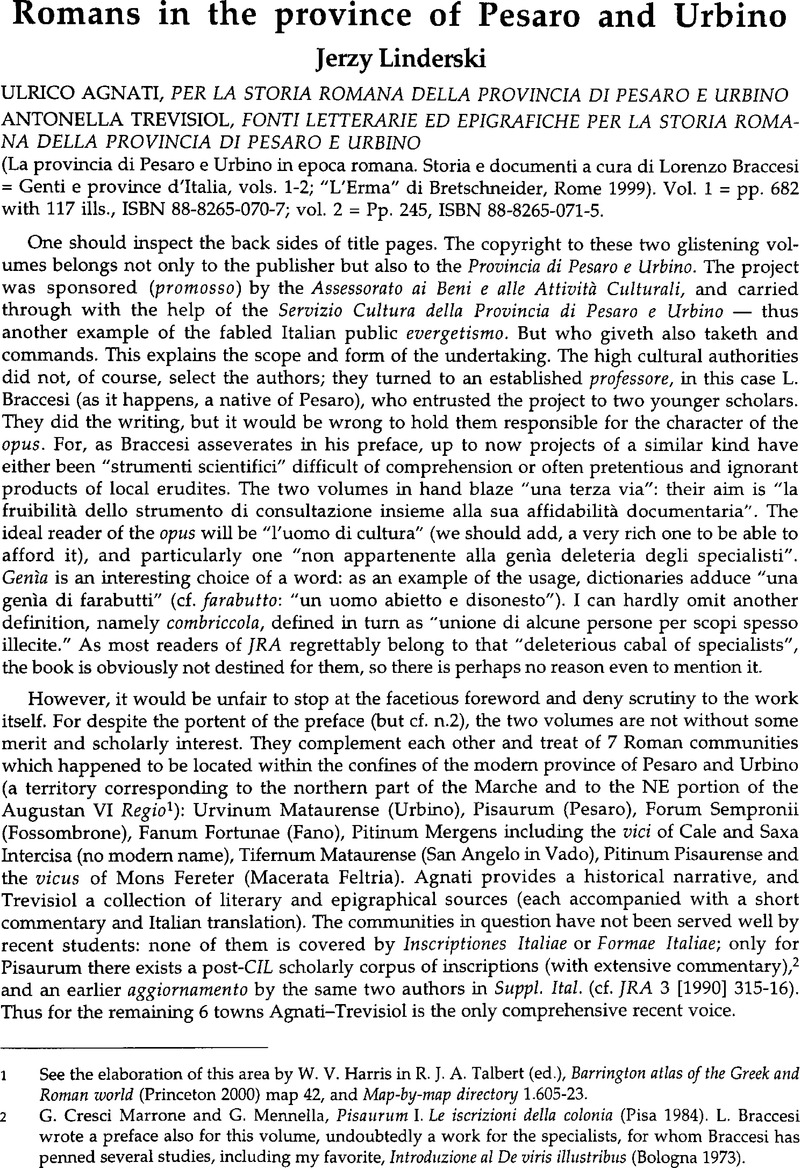No CrossRef data available.
Published online by Cambridge University Press: 16 February 2015

1 See the elaboration of this area by Harris, W. V. in Talbert, R. J. A. (ed.), Barrington atlas of the Greek and Roman world (Princeton 2000) map 42, and Map-by-map directory 1.605-23Google Scholar.
2 Marrone, G. Cresci and Menneila, G., Pisaiiriim I. Le iscrizioni della colonia (Pisa 1984)Google Scholar. L. Braccesi wrote a preface also for this volume, undoubtedly a work for the specialists, for whom Braccesi has penned several studies, including my favorite, Introduzione al De vins illustribus (Bologna 1973)Google Scholar.
3 He is also an accomplished epigraphist with many detailed studies to his credit (e.g., Epigrafia, diritto e società. Studio quantitativo dell'epigrafia latina di zona Insubre (Biblioteca di Athenaeum 34, 1997)Google Scholar.
4 Apparently it is not an ancient etymology; it is not listed in Maltby, R., A lexicon of ancient Latin etymologies (Leeds 1991)Google Scholar, a standard tool not utilized by Agnati.
5 See Demougin, S., Prosopographie des chevaliers romains julio-clandiens (Rome 1992) 38–41 Google Scholar, the most recent discussion of the career of T. Marius (not mentioned by Agnati); she adduced the inscription from Corfinium to elucidate the idiom of Valerius. It is interesting to observe that the only other occurrence of the expression castrensis honos is also in Val. Max. (8.14.5), referring to a military award; cf. Linderski, J., “Silver and gold of valor: the award of armillae and torques ,” Latomns 60 (2001) 4–5, 9 Google Scholar.
6 Perhaps we should read Urvinas; the manuscripts are corrupt and read Urinas and Uirinas. The reading Urbinas is due to Pighius; cf. J. Briscoe in the apparatus in his Teubner edition of Valerius (1998).
7 I did not see the article by Didu, but Menneila, G., “I prefetti degli imperatori a dei cesari,” Epigraphica 50 (1988) 67 Google Scholar, adduces our inscription among 33 other attestations of the office in Italy. He offers no dis cussion of the text.
8 Cf. Orellius, I. C., Inscriptionum Latinarum amplissima collectio 2 (Turici 1828) no. 3714Google Scholar; Wilmanns, G., Exempla inscriptionum Latinarum 1 (Berolini 1873) no. 1459Google Scholar.
9 Cf. Waltzing, J. P., Étude historique sur les corporations professionnelles chez les Romains 3 (Louvain 1899) 509 Google Scholar.
10 See Gimeno, H. and Mayer, M., “Una propuesta de identificación epigráfica: Lara de los Infantes/Nova Augusta,” Chiron 23 (1993) 313–21Google Scholar, with the full indication of (sparse) epigraphical evidence.
11 Petrus Apianus published Inscriptions sacrosanctae vetustatis (Ingolstadt 1534)Google Scholar; Michael Fabricius Ferrarinus (see Mommsen in CIL X, pp. xxxix-xl) composed in the last quarter of the 15th c. an important sylloge of inscriptions (in three editions); on the collectanea (of c.1500) of Iulius Fantagutius (Giuliano Fantaguzzi, a rerum scriptor from Cesena), see ibid. p. xxvii, and Bormann, CIL XI, pp. 3,893.
12 See now Reddé, M., “Legio VIII Augusta,” in Bohec, Y. Le (ed.), Les légions de Rome sous le haut-empire, 1 (Lyon 2000) 123 Google Scholar; cf. Ritterling, E., “Legio,” RE 12.2 (1925) 1652–61Google Scholar.
13 Kienast, D., Römische Kaisertabelle (Darmstadt 1990) 149 Google Scholar. Grosso, F., La lotta politica al tempo di Commodo (Torino 1964) 192–93Google Scholar, assigns the death of Perennis to April or May of 185. For the dating of the inscription this obvious point was already in Wilmanns ad loc. (supra n.8). Consequently he dated the stone to 185/193. We can now do much better.
14 See the list in Fitz, J., Honorific titles of Roman military units in the 3rd century (Budapest 1983) 30–31 Google Scholar.
15 Wilmanns, J. C., “Die Doppelurkunde von Rottweil und ihr Beitrag zum Städtewesen in Obergermanien,” Epigraphische Studien 12 (1981) 50 (the date) and 69–70 (the surnames)Google Scholar.
16 Alföldy, G., “Bellum desertorum,” BJ 171 (1971) esp. 370–72Google Scholar. See also his earlier remarks, Die Legionslegaten der römischen Rheinarmeen (= Epigraphische Studien 3 [1967]) 45, n.232Google Scholar.
17 For this usage, see Cic. Cat. 4.21: Marius, qui bis Italiam obsidione … liberavit (cf. also Rab. perd. 29; Post red. ad Quir. 20); Hist. Aug. 36.4: (Aurelianus) Vindelicos obsidione barbarica liberavit. Cf. TLL s.v. “obsidium,” col. 225.48-53.
18 Cf. Mommsen, T., Römisches Staatsrecht l3 (Leipzig 1887) 573 Google Scholar, with the quotation of our inscription.
19 Filippi, F. (ed.), Alba Pompeia. Archeologia della città dalla fondazione alla tarda antichità (Alba 1997)Google Scholar Cf JRA 14 (2001) 530 Google Scholar.